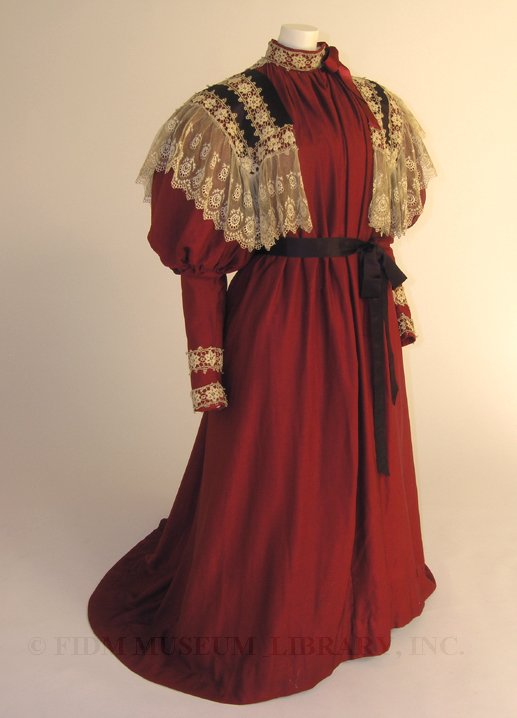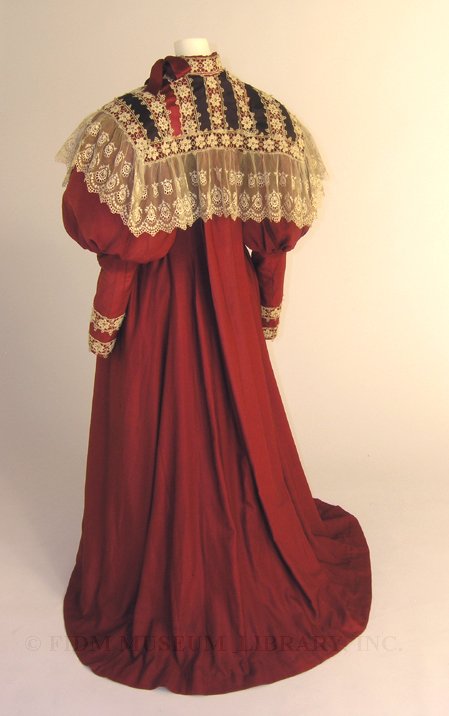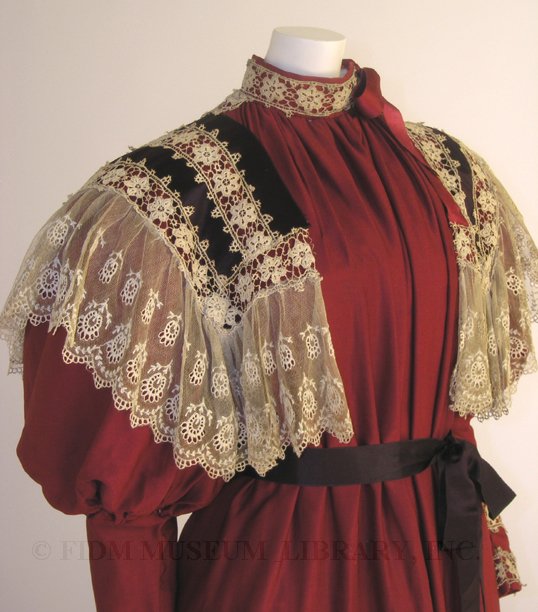Morning gown, c. 1895
For the Victorian woman, correct dress was an essential component of social acceptance. Women of the aristocratic classes and the nouveaux riche changed outfits multiple times each day, always with the knowledge that dress played a crucial role in determining social standing. Understanding the correspondence between the details (trim, fabric, neckline, etc.) of a particular gown and a specific social occasion was valued knowledge, "from which one could not depart without appearing lacking in education."1 Fortunately for the "uneducated," magazines like Harper's Bazaar and Godey's Magazine contained articles on dress and etiquette for all occasions. The gown pictured below is of a type called a morning gown, intended for breakfast at home with the family and possibly some light housework or correspondence.

Morning gown 1893-1897 Gift of Marilyn Habicht S2002.41.1
The high collar, full shoulders and "collarette" of machine lace and ribbon mirror the cut and trim of morning gowns seen in fashion periodicals of the 1890s. Unlike most day and evening dresses of this period, morning gowns were usually cut generously, with a loose, flowing fit and undefined waist. Numerous fashion illustrations indicate that a soft belt of ribbon or cord was often tied loosely around the waist. This FIDM Museum morning gown features a ribbon belt sewn into the side-seams. Another important element of the fashionable morning gown was the Watteau pleat, a soft pleat originating from the upper center back and falling to the hem. Though somewhat obscured by the lace and ribbon collar, the Watteau pleat can be seen in the image below.
Because they were worn only at-home (never outdoors!) a morning gown could be worn without a corset. Harper's Bazaar even went so far as to declare that "corsets should never be tightened until after breakfast."2 This relaxation of physical norms corresponded to the relaxed environment in which a morning gown was meant to be worn. For readers familiar with the tea gown, you'll probably notice some similarities between our morning gown and the similarly relaxed tea gown. Both had a loose fit and were intended for informal at-home events. Additionally, both were considered an appropriate canvas on which to demonstrate an interest in the hallmarks of Artistic Dress, including "odd" colorings and an unstructured fit. The only difference between the two types of gowns appears to be a simple distinction of name, i.e. a morning gown might be similar to a tea gown, but because of its name couldn't be worn out of the house. Though the tea gown eventually escaped the home, becoming appropriate dress for some evening events, the morning gown remained within the home, eventually becoming obsolete.
In addition to providing advice regarding appropriate fabric and trim, fashion periodicals also provided instructions and patterns for making a morning gown at home. This was a practical choice for many women, including the individual who made our morning gown. Though the FIDM Museum morning gown is similar to those seen in fashion periodicals, it lacks a certain finesse in construction and ornamentation that suggests it was made at home. For that reason, it's part of our Study Collection! The most interesting aspect of this particular garment is the sleeve lengths. Look again at the first image and notice that the proper left sleeve is substantially shorter than the proper right sleeve. Close examination of the garment itself suggests that this difference in length was no accident. Perhaps an injury or illness meant that the wearer of this garment had arms of different lengths?
1 Boucher, Francis. 20,000 Years of Fashion. New York: Abrams. 1987: 394. 2 "New York Fashions" Harper's Bazaar 4 July 1896: 563.

